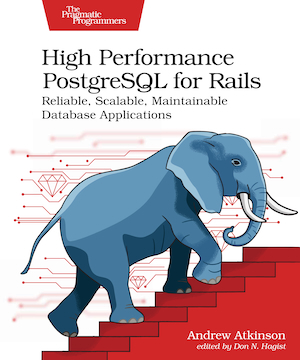- PostgreSQL 17 via Docker
- SQL/JSON and JSON_TABLE
- MERGE Command Basics
- MERGE with RETURNING
- Database Views and Materialized Views
- Trigger-Updatable Views
- Performance Improvements for IN clauses
- Lower memory consumption for VACUUM
- Postgres.fm
- Wrapping Up
It’s time for a new Postgres release! PostgreSQL 17 shipped a few weeks ago, with lots of new features to explore.
As a mature database system, prized for reliability, stability, and backwards compatibility, new features aren’t often the most splashy. However, there are still goodies that could become new tools in the toolboxes of data application builders.
The Postgres 17 release notes is a good starting point, as it covers a breadth of items.
In this post, we’ll pick out three items, and create some runnable examples with commands that can be copied and pasted into a Postgres 17 instance.
Let’s dive in!
PostgreSQL 17 via Docker
To easily try out PostgreSQL 17, let’s use Docker.
docker pull postgres:17
docker run --name my-postgres-container -e POSTGRES_PASSWORD=mysecretpassword -d postgres:17
docker exec -it my-postgres-container psql -U postgres
As an aside: for macOS, if you’re interested in using pg_upgrade, please see the post in-place upgrade from Postgres 14 to 15 as an example on how to upgrade your locally installed, earlier version.
From here, we’ll assume you’re connected to a 17 instance, ready to run commands.
SQL/JSON and JSON_TABLE
Postgres supports SQL/JSON, which is like a selector style expressional language that provides methods to extract data from JSON.
SQL/JSON path expressions specify item(s) to be retrieved from a JSON value, similarly to XPath expressions used for access to XML content.
When we combine SQL/JSON expressions with a new function JSON_TABLE(), we can do powerful transformations of JSON text data into query results that match what you’d get from a traditional table.
Let’s take a look at an example!
Each of these examples will be on this PostgreSQL 17 branch of my pg_scripts repo.
We’ll create a table “books” and insert a row into it. The books table has a “data” column with the “jsonb” data type.
Create the table:
CREATE TABLE IF NOT EXISTS books (
id integer NOT NULL,
name varchar NOT NULL,
data jsonb
);
Use the json_build_object() function to prepare JSON data for storage:
INSERT INTO books (id, name, data)
VALUES (
1,
'High Performance PostgreSQL for Rails',
jsonb_build_object(
'publisher', 'Pragmatic Bookshelf; 1st edition (July 23, 2024)',
'isbn', '979-8888650387',
'author','Andrew Atkinson'));
Now comes the cool part. Use the new JSON_TABLE function as shown below to pull out attribute data from the JSON.
This pulls the publisher, isbn, and author properties from within the JSON. If you’ve used other methods to achieve this before, this syntax hopefully looks much clearer.
SELECT
id,
isbn,
publisher,
author
FROM
books,
JSON_TABLE (data, '$' COLUMNS (
publisher text PATH '$.publisher',
isbn text PATH '$.isbn',
author text PATH '$.author'
)) AS jt;
The nice part is the query result presents these attributes as if they were traditional columns in a table.
id | isbn | publisher | author
----+----------------+--------------------------------------------------+-----------------
1 | 979-8888650387 | Pragmatic Bookshelf; 1st edition (July 23, 2024) | Andrew Atkinson
Read more about JSON_TABLE.
There’s more JSON functionality mentioned in the PostgreSQL 17 Release Notes.
SQL/JSON constructors (JSON, JSON_SCALAR, JSON_SERIALIZE) and query functions (JSON_EXISTS, JSON_QUERY, JSON_VALUE).
What’s next?
MERGE Command Basics
Although the MERGE keyword was added in Postgres 15, it was enhanced in 17. Let’s try it out.
Make two tables, “people” and “employees”.
CREATE TABLE people (
id int,
name text
);
CREATE TABLE employees (
id int,
name text
);
Insert a person:
INSERT INTO people (id, name)
VALUES (1, 'Andy');
We can use the MERGE keyword to perform an “upsert” operation, meaning data is inserted when it doesn’t exist, or updated when it does.
MERGE gained support for the RETURNING clause in PostgreSQL 17. What’s the RETURNING clause?
The RETURNING clause provides one or more fields in the result of INSERT, UPDATE, DELETE, and now MERGE statements, all classified as Data Manipulation Language (DML).
RETURNING avoids a SELECT query following a modification to get the inserted or updated values.
MERGE operations are arguably more declarative than using the ON CONFLICT clause, and MERGE is based on a SQL standard with implementations in other database systems.
MERGE with RETURNING
Let’s try out MERGE without RETURNING:
MERGE INTO employees e
USING people p ON e.id = p.id
WHEN MATCHED THEN
UPDATE SET
name = p.name
WHEN NOT MATCHED THEN
INSERT (id, name)
VALUES (p.id, p.name);
Now we can try it with RETURNING, and include the result:
MERGE INTO employees e
USING people p
ON e.id = p.id
WHEN MATCHED THEN
UPDATE SET name = p.name
WHEN NOT MATCHED THEN
INSERT (id, name)
VALUES (p.id, p.name)
RETURNING *; -- RETURNING CLAUSE HERE, returning all fields with "*"
id | name | id | name
----+------+----+------
1 | Andy | 1 | Andy
(1 row)
Database Views and Materialized Views
Database views gained some enhancements in Postgres 17.
There are both regular views, and materialized views. We’ll focus on regular views for this section.
Besides being defined and queried using SELECT, views can be updated using an UPDATE statement.
Simple views are automatically updatable: the system will allow INSERT, UPDATE, DELETE, and MERGE statements to be used with a view.
What’s new? Besides being updatable using statements, views can also now be updated indirectly by triggers.
Let’s create an example.
Create an employees table where some employees are “admins” and some aren’t. Non-admins can access only non-admins.
DROP TABLE IF EXISTS employees;
CREATE TABLE employees (
id int,
name text,
is_admin boolean
);
INSERT INTO employees (id, name, is_admin)
VALUES (1, 'Andy', TRUE);
INSERT INTO employees (id, name, is_admin)
VALUES (2, 'Jane', FALSE);
INSERT INTO employees (id, name, is_admin)
VALUES (3, 'Jared', FALSE);
Let’s create a view for non-admins:
CREATE VIEW non_admins AS
SELECT
*
FROM
employees
WHERE
is_admin = FALSE;
What would it look like to perform an update using a trigger?
Trigger-Updatable Views
Let’s create an update_employee() function that’s called from a trigger.
Function:
CREATE OR REPLACE FUNCTION update_employee ()
RETURNS TRIGGER
AS $$
BEGIN
UPDATE
employees
SET
is_admin = NEW.is_admin
WHERE
id = OLD.id;
RETURN NEW;
END;
$$
LANGUAGE plpgsql;
Now a trigger that calls the function:
CREATE TRIGGER trigger_update_non_admins
INSTEAD OF UPDATE ON non_admins
FOR EACH ROW
EXECUTE FUNCTION update_employee();
Now we can run an UPDATE on non-admins (updating the view), and verify that the trigger calls the function, updating the underlying “employees” table.
We can even add the RETURNING clause.
After this update, querying non_admins no longer includes user id=2, since they were turned into an admin via the update.
UPDATE non_admins SET is_admin = true where id = 2 RETURNING *;
That wraps up the hands-on items. What are some other noteworthy enhancements?
Performance Improvements for IN clauses
A big one that’s practical for Ruby on Rails apps, is internal improvements for queries with IN clauses and many values.
The Postgres core team was able to eliminate repeated unnecessary index scans, reducing query execution latency, and improving performance.
The cool thing about this one will be that no code changes are required, and the real-world benefits are looking promising.
Check out these blog posts for more info:
- https://dev.to/lifen/as-rails-developers-why-we-are-excited-about-postgresql-17-27nj
- https://www.crunchydata.com/blog/real-world-performance-gains-with-postgres-17-btree-bulk-scans
Lower memory consumption for VACUUM
The release notes explain that PostgreSQL 17 uses a new internal memory structure for vacuum that consumes up to 20x less memory.
This is great because it means that there will be more server memory available for other purposes.
Postgres.fm
For audio coverage, check out the Postgres.fm PostgreSQL 17 episode.
Wrapping Up
Thanks for checking this out! If you spot any SQL issues, please send a Pull Request.

